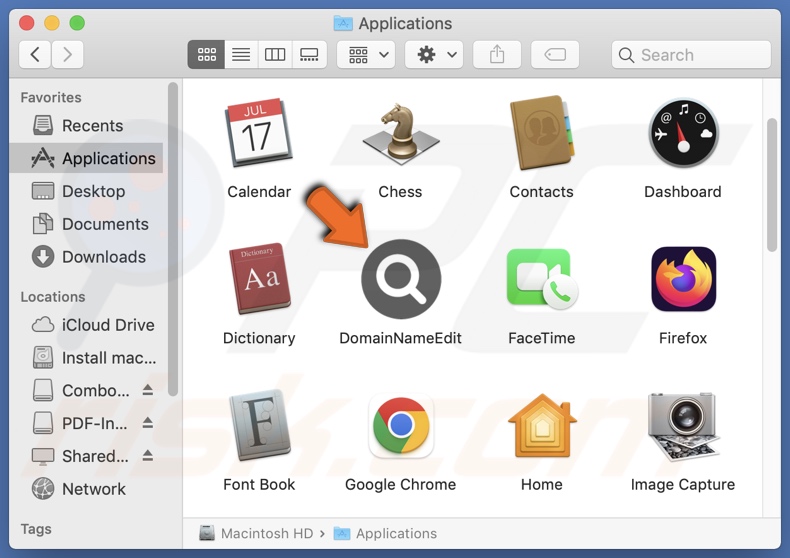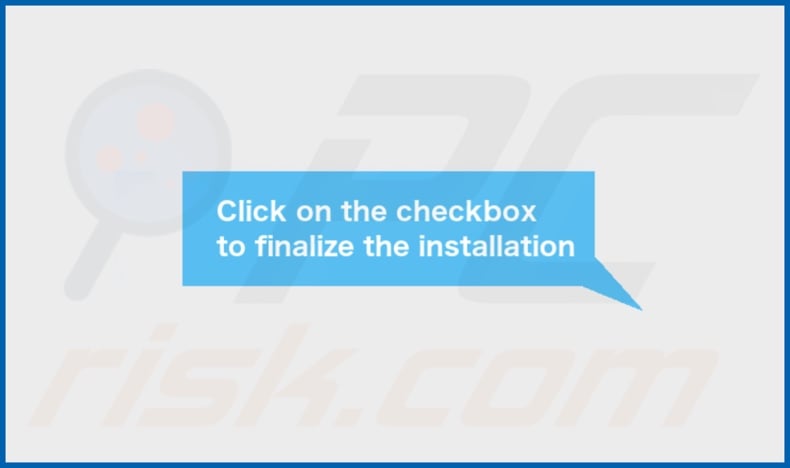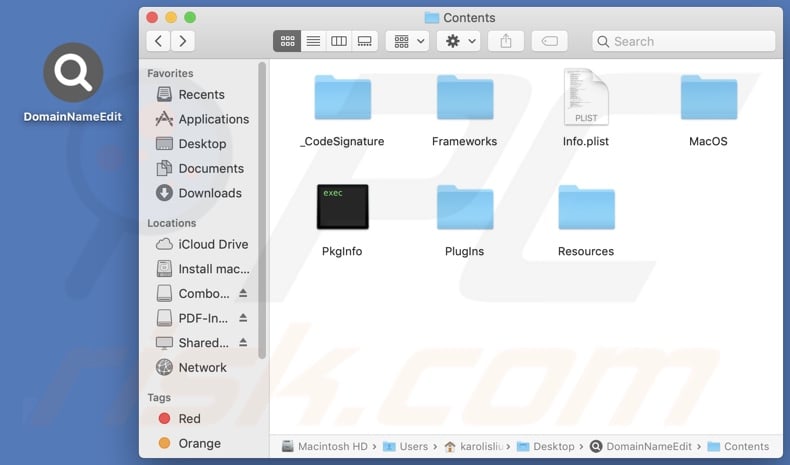Get free scan and check if your device is infected.
Remove it nowTo use full-featured product, you have to purchase a license for Combo Cleaner. Seven days free trial available. Combo Cleaner is owned and operated by RCS LT, the parent company of PCRisk.com.
What kind of application is DomainNameEdit?
DomainNameEdit is a rogue app discovered by our researchers during a routine investigation of new file submissions to the VirusTotal platform. After examining this application, we learned that it is adware from the AdLoad malware family. Advertising-supported software is designed to generate revenue for its developers through advertising.

DomainNameEdit adware overview
Adware usually operates by running intrusive advert campaigns, which involve displaying third-party graphical content (ads) on various interfaces. The advertisements can promote online scams, untrustworthy/hazardous software, and even malware.
Once clicked on, some of these adverts can execute scripts to perform stealthy downloads/installations. Note that any genuine products or services encountered via the ads are most likely endorsed by scammers who abuse the affiliate programs in order to obtain illegitimate commissions.
Advertising-supported software may require certain conditions to deliver intrusive ad campaigns (e.g., compatible browser/system or user geolocation, visits to specific websites, etc.). However, regardless of whether DomainNameEdit displays adverts – its presence on a system remains a threat to device/user safety.
While AdLoad applications often have browser-hijacking capabilities – we did not observe the traits while investigating the DomainNameEdit adware.
Additionally, software within this classification usually has data-tracking functionalities, and this might apply to DomainNameEdit. Adware tends to target browsing and search engine histories, Internet cookies, usernames/passwords, personally identifiable details, finance-related information, and so forth. The collected data can then be shared with and/or sold to third-parties.
To summarize, the presence of software like DomainNameEdit on devices may result in system infections, severe privacy issues, financial losses, and even identity theft.
| Name | Ads by DomainNameEdit |
| Threat Type | Adware, Mac malware, Mac virus |
| Detection Names | Avast (MacOS:Adload-AG [Adw]), Combo Cleaner (Gen:Variant.Adware.MAC.AdLoad.13), ESET-NOD32 (A Variant Of OSX/Adware.Synataeb.H), Kaspersky (Not-a-virus:HEUR:AdWare.OSX.Adload.j), Full List (VirusTotal) |
| Additional Information | This application belongs to Adload malware family. |
| Symptoms | Your Mac becomes slower than normal, you see unwanted pop-up ads, you are redirected to dubious websites. |
| Distribution methods | Deceptive pop-up ads, free software installers (bundling), torrent file downloads. |
| Damage | Internet browser tracking (potential privacy issues), display of unwanted ads, redirects to dubious websites, loss of private information. |
| Malware Removal (Windows) |
To eliminate possible malware infections, scan your computer with legitimate antivirus software. Our security researchers recommend using Combo Cleaner. Download Combo CleanerTo use full-featured product, you have to purchase a license for Combo Cleaner. 7 days free trial available. Combo Cleaner is owned and operated by RCS LT, the parent company of PCRisk.com. |
Adware examples
SaveScheduler, MachineAnalyzer, ObsessionLandscape, ProtocolView, SourceUpdater, and DefaultSection are merely some of our newest articles on adware. This software usually appears harmless and offers various functionalities. However, these functions seldom work as promised, and in most cases – they do not work at all.
It must be emphasized that even if an application or a browser extension operates as indicated by its promotional material – that is not definitive proof of either legitimacy or safety.
How did DomainNameEdit install on my computer?
"Bundling" – packing ordinary program installers with unwanted/malicious additions – is used to distribute adware. Downloading from freeware and free file-hosting sites, P2P sharing networks, and other suspicious sources – poses a threat of bundled content infiltrating the system. This risk is further compounded by treating installations with negligence (e.g., ignoring terms, using "Easy/Express" settings, etc.).
Intrusive advertisements proliferate adware as well. Some of the adverts can be triggered (i.e., by being clicked) to execute scripts that perform sneaky downloads/installations.
Additionally, advertising-supported software is promoted on legitimate-looking download webpages and scam sites. Most visitors access these websites via redirects generated by misspelled URLs, pages employing rogue advertising networks, spam browser notifications, intrusive ads, and installed adware (with browser force-opening abilities).
How to avoid installation of adware?
We highly recommend researching software prior to downloading or purchasing it. Furthermore, all downloads must be made from official and trustworthy channels. Installation processes must be approached with caution, e.g., by reading terms, exploring available options, using the "Custom/Advanced" settings, and opting out of all supplementary apps, extensions, features, etc.
Another recommendation is to be careful while browsing since fraudulent and dangerous online content typically appears legitimate and innocuous. For example, despite their harmless appearance – intrusive advertisements redirect users to unreliable and questionable websites (e.g., scam-promoting, gambling, pornography, etc.).
In case of continuous encounters with such adverts/redirects, inspect the device and immediately remove all dubious applications and browser extensions/plug-ins. If your computer is already infected with DomainNameEdit, we recommend running a scan with Combo Cleaner Antivirus for Windows to automatically eliminate this adware.
Pop-up window displayed once DomainNameEdit adware's installation is over:

DomainNameEdit adware's installation folder:

Instant automatic malware removal:
Manual threat removal might be a lengthy and complicated process that requires advanced IT skills. Combo Cleaner is a professional automatic malware removal tool that is recommended to get rid of malware. Download it by clicking the button below:
DOWNLOAD Combo CleanerBy downloading any software listed on this website you agree to our Privacy Policy and Terms of Use. To use full-featured product, you have to purchase a license for Combo Cleaner. 7 days free trial available. Combo Cleaner is owned and operated by RCS LT, the parent company of PCRisk.com.
Quick menu:
- What is DomainNameEdit?
- STEP 1. Remove DomainNameEdit related files and folders from OSX.
- STEP 2. Remove DomainNameEdit ads from Safari.
- STEP 3. Remove DomainNameEdit adware from Google Chrome.
- STEP 4. Remove DomainNameEdit ads from Mozilla Firefox.
Video showing how to remove DomainNameEdit adware using Combo Cleaner:
DomainNameEdit adware removal:
Remove DomainNameEdit-related potentially unwanted applications from your "Applications" folder:

Click the Finder icon. In the Finder window, select "Applications". In the applications folder, look for "MPlayerX","NicePlayer", or other suspicious applications and drag them to the Trash.
After removing the potentially unwanted application(s) that cause online ads, scan your Mac for any remaining unwanted components.
DOWNLOAD remover for malware infections
Combo Cleaner checks if your computer is infected with malware. To use full-featured product, you have to purchase a license for Combo Cleaner. 7 days free trial available. Combo Cleaner is owned and operated by RCS LT, the parent company of PCRisk.com.
Remove adware-related files and folders

Click the Finder icon, from the menu bar. Choose Go, and click Go to Folder...
 Check for adware generated files in the /Library/LaunchAgents/ folder:
Check for adware generated files in the /Library/LaunchAgents/ folder:

In the Go to Folder... bar, type: /Library/LaunchAgents/

In the "LaunchAgents" folder, look for any recently-added suspicious files and move them to the Trash. Examples of files generated by adware - "installmac.AppRemoval.plist", "myppes.download.plist", "mykotlerino.ltvbit.plist", "kuklorest.update.plist", etc. Adware commonly installs several files with the exact same string.
 Check for adware generated files in the ~/Library/Application Support/ folder:
Check for adware generated files in the ~/Library/Application Support/ folder:

In the Go to Folder... bar, type: ~/Library/Application Support/

In the "Application Support" folder, look for any recently-added suspicious folders. For example, "MplayerX" or "NicePlayer", and move these folders to the Trash.
 Check for adware generated files in the ~/Library/LaunchAgents/ folder:
Check for adware generated files in the ~/Library/LaunchAgents/ folder:

In the Go to Folder... bar, type: ~/Library/LaunchAgents/

In the "LaunchAgents" folder, look for any recently-added suspicious files and move them to the Trash. Examples of files generated by adware - "installmac.AppRemoval.plist", "myppes.download.plist", "mykotlerino.ltvbit.plist", "kuklorest.update.plist", etc. Adware commonly installs several files with the exact same string.
 Check for adware generated files in the /Library/LaunchDaemons/ folder:
Check for adware generated files in the /Library/LaunchDaemons/ folder:

In the "Go to Folder..." bar, type: /Library/LaunchDaemons/

In the "LaunchDaemons" folder, look for recently-added suspicious files. For example "com.aoudad.net-preferences.plist", "com.myppes.net-preferences.plist", "com.kuklorest.net-preferences.plist", "com.avickUpd.plist", etc., and move them to the Trash.
 Scan your Mac with Combo Cleaner:
Scan your Mac with Combo Cleaner:
If you have followed all the steps correctly, your Mac should be clean of infections. To ensure your system is not infected, run a scan with Combo Cleaner Antivirus. Download it HERE. After downloading the file, double click combocleaner.dmg installer. In the opened window, drag and drop the Combo Cleaner icon on top of the Applications icon. Now open your launchpad and click on the Combo Cleaner icon. Wait until Combo Cleaner updates its virus definition database and click the "Start Combo Scan" button.

Combo Cleaner will scan your Mac for malware infections. If the antivirus scan displays "no threats found" - this means that you can continue with the removal guide; otherwise, it's recommended to remove any found infections before continuing.

After removing files and folders generated by the adware, continue to remove rogue extensions from your Internet browsers.
Remove malicious extensions from Internet browsers
 Remove malicious Safari extensions:
Remove malicious Safari extensions:

Open the Safari browser, from the menu bar, select "Safari" and click "Preferences...".

In the preferences window, select "Extensions" and look for any recently-installed suspicious extensions. When located, click the "Uninstall" button next to it/them. Note that you can safely uninstall all extensions from your Safari browser - none are crucial for regular browser operation.
- If you continue to have problems with browser redirects and unwanted advertisements - Reset Safari.
 Remove malicious extensions from Google Chrome:
Remove malicious extensions from Google Chrome:

Click the Chrome menu icon ![]() (at the top right corner of Google Chrome), select "More Tools" and click "Extensions". Locate all recently-installed suspicious extensions, select these entries and click "Remove".
(at the top right corner of Google Chrome), select "More Tools" and click "Extensions". Locate all recently-installed suspicious extensions, select these entries and click "Remove".

- If you continue to have problems with browser redirects and unwanted advertisements - Reset Google Chrome.
 Remove malicious extensions from Mozilla Firefox:
Remove malicious extensions from Mozilla Firefox:

Click the Firefox menu ![]() (at the top right corner of the main window) and select "Add-ons and themes". Click "Extensions", in the opened window locate all recently-installed suspicious extensions, click on the three dots and then click "Remove".
(at the top right corner of the main window) and select "Add-ons and themes". Click "Extensions", in the opened window locate all recently-installed suspicious extensions, click on the three dots and then click "Remove".

- If you continue to have problems with browser redirects and unwanted advertisements - Reset Mozilla Firefox.
Frequently Asked Questions (FAQ)
What harm can adware cause?
The presence of adware can diminish the browsing experience and system performance. This software displays ads that may endorse content capable of causing severe issues (e.g., system infections, financial losses, etc.). Adware usually has data-tracking abilities – hence, it is considered a threat to user privacy.
What does adware do?
Adware stands for advertising-supported software. It is designed to deliver intrusive advertisement campaigns. Typically, this software operates by displaying third-party graphical content (ads) on various interfaces. Some adware types are also capable of force-opening webpages and gathering sensitive information.
How do adware developers generate revenue?
Adware generates revenue through content endorsement (e.g., websites, products, services, etc.). The developers may earn commissions from ad clicks, site visits, file downloads, product purchases, service subscriptions, or similar. The majority of the profit comes from affiliate programs.
Will Combo Cleaner remove DomainNameEdit adware?
Yes, Combo Cleaner is capable of scanning devices and eliminating detected adware-type applications. Keep in mind that manual removal (unaided by security programs) might be ineffective. In some instances, after the advertising-supported software has been manually removed – various leftovers (files) stay hidden within the system. These remnants might continue to run and cause issues. Therefore, it is paramount to eliminate adware and other unwanted software thoroughly.
Share:

Tomas Meskauskas
Expert security researcher, professional malware analyst
I am passionate about computer security and technology. I have an experience of over 10 years working in various companies related to computer technical issue solving and Internet security. I have been working as an author and editor for pcrisk.com since 2010. Follow me on Twitter and LinkedIn to stay informed about the latest online security threats.
PCrisk security portal is brought by a company RCS LT.
Joined forces of security researchers help educate computer users about the latest online security threats. More information about the company RCS LT.
Our malware removal guides are free. However, if you want to support us you can send us a donation.
DonatePCrisk security portal is brought by a company RCS LT.
Joined forces of security researchers help educate computer users about the latest online security threats. More information about the company RCS LT.
Our malware removal guides are free. However, if you want to support us you can send us a donation.
Donate
▼ Show Discussion